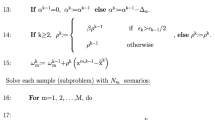Abstract
This paper deals with a multi-level warehouse layout problem under fuzzy environment, in which different types of items need to be placed in a multi-level warehouse and the monthly demand of each item type and horizontal distance traveled by clamp track are treated as fuzzy variables. In order to minimize the total transportation cost, chance-constrained programming model is designed for the problem based on the credibility measure and then tabu search algorithm based on the fuzzy simulation is designed to solve the model. Some mathematical properties of the model are also discussed when the fuzzy variables are interval fuzzy numbers or trapezoidal fuzzy numbers. Finally, a numerical example is presented to show the efficiency of the algorithm.
Similar content being viewed by others
References
Dubois, D. & Prade, H. (1988). Possibility Theory. New York: Plenum
Glover, F. (1986). Future paths for integer programming and links to artificial intelligence. Computers and Operations Research, 13: 533–549
Glover, F. (1989). Tabu search: part I. ORSA Journal on Computing, 1: 190–206
Glover, F. (1990). Tabu search: part II. ORSA Journal on Computing, 2: 4–32
Kusiak, A. & Heragu, S. (1987). The facility layout problem. European Journal of Operational Research, 29: 229–251
Lai, K.K., Xue, J. & Zhang, G. (2002). Layout design for a paper reel warehouse: A two-stage heuristic approach. International Journal of Production Economics, 75: 231–243
Larson, T.N., March, H. & Kusiak, A. (1997). A heuristic approach to warehouse layout with class-based storage. IIE Transactions, 29: 337–348
Liu, B. (2002). Theory and Practice of Uncertain Programming. Physica-Verlag, Heidelberg
Liu, B. & Liu, Y. (2002). Expected value of fuzzy variable and fuzzy expected value models. IEEE Transactions on Fuzzy Systems, 10: 445–450
Meller, D. & Bozer, Y.A. (1997). Alternative approaches to solve the multi-floor facility layout problem. Journal of Manufacturing System, 16(3): 192–203
Zhang, Q., Lai, K.K. & Yang, L.X. (2002). A fuzzy multiple-level warehouse layout problem. In: Proceedings of the 9th Bellman Continuum International Workshop on Uncertain Systems and Soft Computing, 236–239, Beijing, 2002
Zhang, G.Q., Xue, J. & Lai, K.K. (2000). An improved GA for layout problem with adjacent constraints. International Journal of Production Research, 38(14): 3343–3356
Zhang, G.Q. & Lai, K.K. (2000). An assignment approach for a new multiple-level warehouse layout problem. APIEMS Conference Proceeding, 2000
Zadeh, L.A. (1978). Fuzzy sets as a basis for a theory of possibility. Fuzzy Sets and Systems, 1: 3–28
Author information
Authors and Affiliations
Corresponding author
Additional information
This research is supported by Rencai Foundation of Beijing Jiaotong University (No. 2005RC035), and Research Foundation of Beijing Jiaotong University (No. 2005SM028)
Lixing Yang was born in Hebei province in 1976, and received B.S. and M.S. degrees from College of Mathematics and Computer, Hebei University in 1999 and 2002, respectively. After have receiving Ph.D. degree from Tsinghua University in 2005, he came to Beijing Jiaotong University to be a lecturer. He has published more than ten papers up to now. His current research interests include uncertain programming, fuzzy measure theory, and intelligent systems, etc.
Yuan Feng was born in Hebei province in 1976, and received B.S. degree from Hebei Normal University in 1998. In 2002, she received M.S. degree from the College of Mathematics and Computer, Hebei University. After that, she came to College of Mathematics & Physics, Beijing Institute of Petro-chemical Technology. She has published more than ten papers up to now, and her current research interests include fuzzy measure theory, fuzzy programming, etc
Rights and permissions
About this article
Cite this article
Yang, L., Feng, Y. Fuzzy multi-level warehouse layout problem: New model and algorithm. J. Syst. Sci. Syst. Eng. 15, 493–503 (2006). https://doi.org/10.1007/s11518-006-5017-3
Issue Date:
DOI: https://doi.org/10.1007/s11518-006-5017-3




